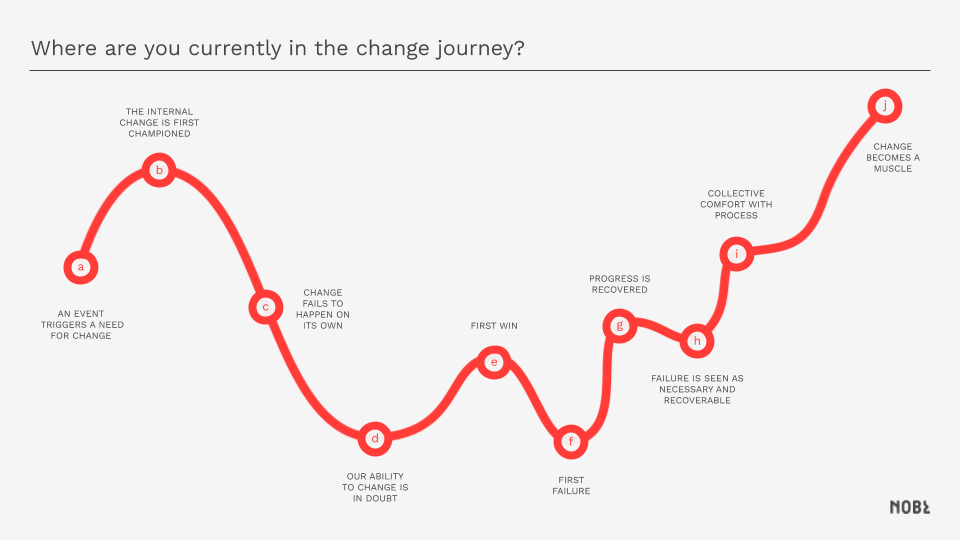Congratulations: you’ve convinced everyone that a change is needed, and everyone’s excited to try doing things differently. In the beginning, everything goes great. Teams are holding more efficient meetings, or decisions are being made faster, or silos are coming down. But then an emergency comes up, or another team is roped into a project, and you don’t have time to train them on the new approach… and before you know it, a few months have gone by and you’re back to doing things the old way. If everyone’s technically on board, why do organizations slip back into old habits?
The more you can demonstrate that setbacks are a natural part of the change journey, the better your team will shake off disappointment and keep moving forward.
This common barrier to change is Backsliding, and it’s driven by:
- Time or performance pressures, caused by either internal or external shocks. Worse, when leaders put pressure on teams to get things done at any cost, it sends the message that change isn’t a priority—after all, we can still deliver results without being different. While this may be true in the short-term, it won’t address the underlying changes that necessitated change in the first place.
- Initiative fatigue. Ambitious leaders know a lot needs to change within organizations, but introducing too many projects at once can distract and overwhelm teams. This can also look like “management by book club,” where teams are forced to continuously adopt the latest management fad.
- Changing up participants. If you add teams before the new habit is fully engrained, you risk defaulting to the “shared language” of doing things the old way. Transitioning the leader who led the successful transformation too soon (even if it’s for a good reason, like a promotion) can also impact the transformation.
Given how often these interruptions occur, most change initiatives will experience some level of backsliding. When this happens, cynics often emerge triumphant—”see, change can’t happen here.” But if you anticipate backsliding and have a plan to overcome it, you can turn it into a momentary slip, and not a reason to give up on the change program entirely.


NOBL has helped world-famous organizations change collective behavior and business outcomes. Reach out to see how we might be able to help your organization.
The fact is that as much as leaders might like for change to be a continuous, steady march of progress, any change initiative will go through pauses, digressions, and failures. The more you can demonstrate that setbacks are a natural part of the change journey, the better your team will shake off disappointment and keep moving forward. To overcome backsliding:
- Define, for yourself, the difference between a “first slip” and a “lapse.” The former is a temporary pause, while the latter is permanent—and a slip doesn’t inevitably become a lapse. Evaluate, in advance, what these might look like in your organization, and how you’ll respond to each. Remember, if you acknowledge that slips are a natural response to change, you won’t feel deflated, and leaders won’t be overly concerned, when they inevitably occur. Provide similar coaching to others so that when they experience backsliding, they see it as something to be overcome, not a reason to give up.
- Implement one new change at a time. To avoid initiative fatigue, give new behaviors time to stick before attempting another massive change. This may require a longer timespan than you expect—research indicates that results return to the baseline in a quarter of initiatives after a year, and that number drops to half after two years. If you must introduce more changes in quick succession, track metrics to ensure continued adherence, and try to make additional changes consistent with the existing initiatives.
- Prepare strategies to overcome backsliding in advance. One of the most effective ways to prevent backsliding is to prepare with pre-mortems: bring the team together to identify what might affect the change in the coming months (e.g., do you know a seasonal busy period will take place halfway through the planned change? Is there already a full slate of initiatives planned?). Then, brainstorm ways to either avoid those problems, or come up with a plan for what to do when they do arise.
- Be ready to step in in high-risk situations. In particular, keep an eye out for teams experiencing high-risk situations (e.g., time pressure) and intervene to help them maintain their focus. Can you move work off their plate? Reduce the number of change initiatives they’re expected to manage? Showing that you’re prepared to support the team can be just as powerful as the intervention itself.
- Ensure both accountability and support exist among those being asked to change their behavior. If leaders aren’t visibly and consistently supporting the ongoing change, teams have a tendency to believe the change no longer matters—so make sure managers are tracking performance metrics and providing assistance when change gets hard. This is also important when onboarding new individuals and teams: they need both a clear understanding of expected behavior, and the training and support needed to adapt.
- Continually renew focus on the transformation and its goals. Over time, people tend to forget why they’re going through the transition in the first place, so remind people about what you’re doing and why. That’s especially true as individuals see diminishing returns after a big initial success. Connect the desired behavior to both the organization’s larger purpose and the individual’s goals—why will these changes benefit them in the long run? Celebrate continued progress and milestones to continue reinforcing desired behaviors.








The Evolutionary Edge
Every Link Ever from Our Newsletter
Why Self-Organizing is So Hard
Welcome to the Era of the Empowered Employee
The Power of “What If?” and “Why Not?”
An Adaptive Approach to the Strategic Planning Process
Why Culture/Market Fit Is More Important than Product/Market Fit
Group Decision Making Model: How to Make Better Decisions as a Team